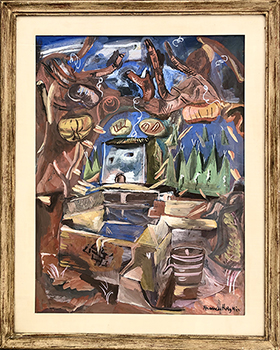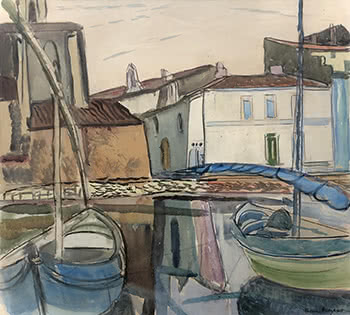Four works by Frances Hodgkins Fri, 18 Mar 2022

Pergola was exhibited in New Paintings and Watercolours by Frances Hodgkins at the Lefevre Galleries between October and November in 1937, alongside Side Entrance, c. 1932. A complex composition, it is derived from the highly productive time Hodgkins spent at Tossa de mar on the Costa Brava (Wild Coast) in northern Spain from mid- September 1935 to early summer 1936. There was a strong Parisian presence among the summer guests, who loved the sparkling blue sea and brilliant skies, Marc Chagall christening it a 'Blue Paradise' while Dora Maar photographed her intellectual friends perched on the edge of brightly painted fishing boats pulled up on the shore. Once the autumn winds started to blow, most preferred to return to home. But Hodgkins was made of sterner material, the more isolated months giving her the quiet she needed to focus on her compositions without too much interruption. The sweeping curve of the main bay, La Pauma (La Palma), lies spread out below pine-covered hills that rise above the village, marked at one end by the castellated ruins of Vila Vella, the sole remaining medieval fortification on the Catalan coast. When she wasn't recording its imposing structure, Hodgkins preferred the isolation at the opposite end of the bay, not least when the river, which dried up in the summer months, burst forth once temperatures cooled. Its flow was vital for irrigating the patchwork of fields that provided much of Tossa's food supply. Hodgkins was drawn, not to the flat rows of vegetables, but rather the infrastructure that supported their growth. Her time in Tossa de mar was extremely productive for Hodgkins, inspiring at least a dozen of the major paintings included in the Lefevre exhibition the following year. Pergola is a delight to study, as its location has been unknown until recently. Its subject matter, however, making witty references to several major works from the 1930s, each painting more refined than the last. Hodgkins first introduced the pergola motif into watercolours painted in St Tropez in 1931, producing an internal floral frame for a local woman washing garments at an outdoor sink., while in several English watercolours in the intervening years, including Side Entrance, it draws the eye through to the view beyond. In Pergola the title is given to a heavily pruned tree on the left-hand side, its arch of truncated branches framing a lone white building. You can always tell when Hodgkins feels on top of her game, for the house takes on an anthropomorphic quality, its unevenly placed windows serving as eyes that gaze quizzically back at us. Floating around but not attached to the pergola are vegetal forms suggestive of seeds, gourds, and marrows, interspersed by white curlicues that rise like wisps of smoke that appear to be 'embroidered' on the surface. Patches of 'blanket stitch' on the pruned branches heighten this effect. The river itself flows under the bridge in front of the house before being briefly captured in the lavadero in the foreground, where fishermen's wives gathered daily, scrubbing their washing on the flat tops of the broad stone walls. While Hodgkins has consciously avoided the introduction of such figures into her Tossa paintings, her letters of the time attest to the women's presence. [https://completefranceshodgkins.com/ objects/29967/letter-from-frances-hodgkins-todorothy- selby] A water barrel on the right, which would have been filled by hand to aid the villagers' endeavours, stands guard on the right of the wall, while the water, having served its purpose, then gushed beneath the walls before spreading its largesse over the expanse of the beach before reaching the sea. Buildings and walls allowed Hodgkins to introduce reminiscences of Cubist forms, this treatment possibly influenced by the 'Parisian' element of Tossa's summer population. Either side, looking like Indian wigwams, are paller or haystacks, the hay being packed around a central tripod of bamboo. They can be seen in several Tossa paintings, including Spanish Landscape with Stooks in Grey and Pink and Spanish Landscape in Orange, Brown and Green, although in the latter they are to be clad in their freshly cut mantle. Beautifully constructed, its sombre palette of browns and greens lifted by sparkling blues and whites reflective of the local marine environment, Pergola is a masterpiece.
MARY KISLER

If Hodgkins' watercolour of Caudebec-en-Caux demonstrated her skilled handling of the medium and celebrated a type of impressionist approach to landscape, the 1920s saw a marked change of approach. The fishing villages on the French Riviera played a major part in Hodgkins' ongoing development as a modernist. After staying briefly in St Tropez at the beginning of December 1920, Hodgkins moved west to Cassis before settling for some time in Martigues. Since the 19th century, these villages have been a favoured location for artists, Martigues particularly favoured by Andr Derain, Raoul Dufy, Camille Corot, and Matthew Smith. Even today Martigues remains a resolute little fishing village, charming when bathed in the warm Mediterranean sun but also prone to being swept by the fierce dusty winds that make their way across north Africa before depositing their grit on its local streets, while surprisingly crisp in winter, when Hodgkins chose to work there. The port sits at the mouth of a huge lagoon known as l' tang de Berre, which makes its way to the sea by way of the Caronte canal. In the port itself, today the original five narrow islets are linked by bridges, making it easy to walk the tiny distance from one strip of land to another. In a letter written to Rachel Hodgkins when Frances first arrived, she noted; Martigues is called the Venice of France. . . A rather grandiloquent name for a very dirty little fishing village, on one of the indefatigable mouths of the Rhone, a few miles to the westward of Marseilles - it's as filthy as it's picturesque. . . We thought this a more suitable place for pupils & cheaper & less out of the way and a good half way stage before we push further South towards Spain. . . The food is wonderfully good - floors are cold - light poor, but the dear sun which makes up for all… https:// completefranceshodgkins.com/objects/29522/ letter-from-frances-hodgkins-to-rachel-hodgkins Her more experimental watercolours, however, were all created en plein air, in which she developed a new approach to working with colour, spurred by the cheerful simplicity of her setting. Colour resonates in Martigues, not least in the smaller islets, but the most popular location to set up an easel is Le Miroir aux Oiseaux, or Mirror of Birds. A small L-shaped inlet leading off the mouth of one of the canals, artists are attracted to its sheltered location and the effects of the sparkling water when the sun shines. Wrapped around Le Miroir is the Quai Brescon, lined by fisherman's cottages painted in various hues, either on the whole fa ade or gaily outlining windows, doors, and shutters. These colours are reflected in the fishermen's boats, riding at anchor. While Hodgkins' simplified forms suggest aspects of the Cubist movement in Paris, she was reminded of the simple architecture which had captured her imagination in Morocco in 1901-02, and the way in which their forms are accentuated by the strong Mediterranean light. In Venetian Lagoon, she has rapidly blocked in the patterns of earthenware tiles on roofs, while simplifying the arches of L'Eglise Sainte- Madeleine-de-l' le (the Church of St Madeleine of the Island) which can be made out on the left in the background, and the curving forms of the fishing boats drawn up beside the Quai, their brightly painted hulls echoing the myriad colours of windows and doors in the background. Furled sails on the boat on the right provide animation, while an angled wooden mast divides up the structure of the church. But there is another innovation here, which was to become a leitmotif of her Martigues paintings in the five visits made to the village from 1921 - 31. Unlike most fishing ports, which have a constant flow of boats entering and departing port, Le Miroir gets its name from its glassy surface, undisturbed for much of the day once boats have set out to work. What Hodgkins now sought to capture was the effect of reflections on her compositions, as illustrated in the central section of Venetian Lagoon. At each visit throughout the 1920s, she continued to explore the opportunities provided by their shimmering effects, and the contrast they provided with their bustling surroundings.
MARY KISLER
